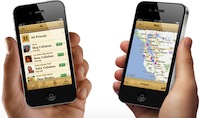 Apple has an unimpeachable reputation as an innovator. But nothing is created in a vacuum. From the famous adaptation of the by-then well-established (among techies) “windows” concept to its late entry to the MP3 and smartphone market, Apple has judiciously built off other people’s ideas – as others have richly done with Apple’s.
Apple has an unimpeachable reputation as an innovator. But nothing is created in a vacuum. From the famous adaptation of the by-then well-established (among techies) “windows” concept to its late entry to the MP3 and smartphone market, Apple has judiciously built off other people’s ideas – as others have richly done with Apple’s.
It’s hard to imagine Android without the benefit of the iPhone’s iOS software. In fact, Android sometimes looks like a creepy doppelganger.
But having launched the new world of touch-interface smartphones, Apple has created a universe in which other companies also innovate. And Apple has the good sense to borrow their ideas, as others have borrowed from Apple.
Notification Center was the first obvious adaptation in iOS 5 – basically a copy of Android’s clever swipe-down menu (replacing the infuriating firehose of popups in the previous iOS versions.)
And yesterday’s presentation featured more examples of Apple smartly learning from is peers – in particular, from the creativity of app designers.
How can we know that Apple was inspired by these other apps? Well it’s hard to believe that Apple doesn’t carefully follow the market – especially since most of these apps are in the company’s own App Store market.
Following are some of the new iOS 5 features and their likely inspirations:
1) Find my Friends – provides a list of people and their locations on GPS.

This is a great feature of GroupMe, a group-messaging app launched in 2010.
2) Temporary sharing of location with Find My Friends – you can set the timeframe in which people can know your location.
Several companies introduced this idea – to take the creep factor out of location based apps like Foursquare – starting in 2009 (and in all fairness, Foursquare has always made location sharing opt-in for only when you want to use it). Both Glympse and Geoloqi let you share location with specific people for specific time periods.
Neer, an experiment from a skunkworks inside Qualcomm, adds geofencing, so your friends or family will know your whereabouts only when you get to certain locations, such as work or home, and only during certain times.
3) iMessage allows free messaging among iPhone/iPad/iPod touch users.
Once again, we have GroupMe – whose main purpose it to provide this function, as well as the app textPlus. And they also work on Android devices. Both are free, although textPlus requires you to pay $3 per year if you don’t want to look at ads.
4) Siri – the personal digital assistant, processes voice commands using the awesome Nuance technology to do things like provide advice about the weather, tell the time, give directions, and book appointments.
This of course is a great capability of Google’s Voice Actions, an app that integrates into the Android OS to do many of the same things.
And in a way, siri is also an adaptation of, well, siri – since Apple bought the app provider two years ago and then integrated it into iOS. To their credit, Apple kept the name “siri,” honoring the original app.








